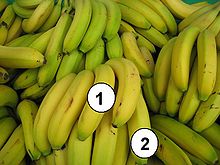Regulation (EC) No. 2257/94
|
Regulation (EC) No. 2257/94 |
|
|---|---|
| Title: | Regulation (EC) No. 2257/94 of the Commission of 16 September 1994 setting quality standards for bananas |
| Designation: (not official) |
Banana regulation |
| Scope: | EEA |
| Legal matter: | Business law , food law |
| Basis: | Regulation (EEC) No. 404/93 , as amended by Regulation (EC) No. 3518/93 , in particular on Art. 4 |
| To be used from: | January 1, 1995 |
| Last change by: | Regulation (EC) No. 228/2006 |
|
Effective date of the last change: |
February 17, 2006 |
| Replaced by: | Implementing Regulation (EU) No. 1333/2011 |
| Reference: | OJ L 245 of 20.9.1994, pp. 6-10 |
| Full text |
Consolidated version (not official) basic version |
| Regulation has expired. | |
| Please note the information on the current version of legal acts of the European Union ! | |
The Regulation (EC) no. 2257/94 is a Regulation (EC) of the European Commission , the properties and classification of imported bananas describes legally binding. Bananas that conform to this standard are also jokingly referred to as euro bananas .
Provisions
The aim of Regulation (EC) No. 2257/94 is to standardize the provisions of the individual member states for imported bananas and to introduce a minimum standard to ensure the quality and smooth transport of the fruit.
size
The Regulation must bananas into the EU will be introduced, and bananas produced within the EU a minimum length of 14 cm and have a thickness of at least mm 27th
Status
They must also be undamaged (intact skin, no bruises, no mold , no kinked handle, etc.), must not have ripened (green color of the skin) and must be free of deformities or abnormal growth. The so-called banana hands or clusters (several fruits on a piece of stem) must have an intact piece of crown with a smooth interface that holds the individual bananas together. Furthermore, the bananas must have a degree of ripeness that allows them to be transported and then left to ripen.
Bananas are divided into three classes according to their external properties. Bananas in the "Extra" class may only have marginal damage that does not exceed 1 cm²; they must also have the characteristics typical of their variety. The Class I includes bananas with slight superficial damage and deformation, but otherwise typical features. Under Class II eventually fall all the bananas that do not meet the criteria of the higher classes, but otherwise conform with the provisions of the Regulation.
Packaging and presentation
The regulations stipulate that each cluster must have at least four bananas. The packs with the clusters must also be adequately labeled with regard to the type of product, origin, weight and quality class.
Exceptions
There are special regulations for bananas that are grown in certain growing areas within the EU (such as Crete or Madeira ). They may fall below the permitted minimum sizes, since the bananas grown there usually do not reach the standard size. However, they then automatically fall under class II.
Plantains , fig bananas and bananas used for industrial processing are not covered by the regulation.
Review of the criteria
The measurement method is prescribed insofar as the length of the fruit is measured over its outer curvature from the base of the stem to the end of the flower and the thickness of the fruit is determined by the diameter in the middle of the fruit. The middle banana in the outer row and the outermost fruit in the outer row are decisive for the measurement.
criticism
The regulation is often used in the media and in public as an example of excessive bureaucracy and “regulatory mania” in the EU. It is also often claimed that the EU stipulates the degree of curvature of the imported banana. However, this is not mentioned in the regulation.
Non-tariff trade barriers such as the banana regulation are also often criticized as disadvantaging non-EU countries because they make it difficult to trade freely with foreign suppliers.
